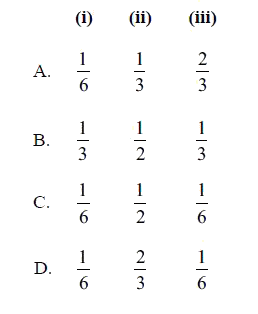A die having numbers 1, 2, 4, 6, 7 and 8 on its faces, is rolled once. Find the probability of getting
(i) an even prime number.
(ii) a number greater than 3.
(iii) a multiple of 2 which is less than 4.

The correct Answer is:D
Step by step video, text & image solution for A die having numbers 1, 2, 4, 6, 7 and 8 on its faces, is rolled once. Find the probability of getting (i) an even prime number. (ii) a number greater than 3. (iii) a multiple of 2 which is less than 4. by Maths experts to help you in doubts & scoring excellent marks in Class 9 exams.
Updated on:21/07/2023Topper's Solved these Questions
- IMO QUESTION PAPER 2018 SET ABOOK - SCIENCE OLYMPIAD FOUNDATION CHAPTER - IMO QUESTION PAPER 2018 SET AEXERCISE - EVERYDAY MATHEMATICS
10 Videos
- IMO QUESTION PAPER 2017 SET BBOOK - SCIENCE OLYMPIAD FOUNDATION CHAPTER - IMO QUESTION PAPER 2017 SET BEXERCISE - ACHIEVERS SECTION
5 Videos
- IMO QUESTION PAPER 2018 SET B BOOK - SCIENCE OLYMPIAD FOUNDATION CHAPTER - IMO QUESTION PAPER 2018 SET B EXERCISE - Achievers Section
5 Videos
Similar Questions
Knowledge Check
An unbiased die is rolled find the probability of
getting a prime number.A12B35C57D58
An unbiased dice is rolled once. What is the probability of getting an even prime number?
View SolutionA die is thrown. Find the probability of getting: (i) an even prime number (ii) a number greater than 5 (iii) a number lying between 2 and 6
View SolutionA die is thrown once .Find the probability of getting
(i) a composite number , (ii) a prime number.
View SolutionWhen a fair die is rolled once, then
What is probability of getting an even prime number ?
View SolutionA die is thrown once. Find the probability of getting (1) a composite number, (ii) a prime number.
View SolutionA die is thrown once. Find the probability of getting(i) a prime number; (ii) a number lying between 2 and 6; (iii) an odd number.
View SolutionA die is trouwn once. Find the probability of getting an even number less than 5.
View Solution
